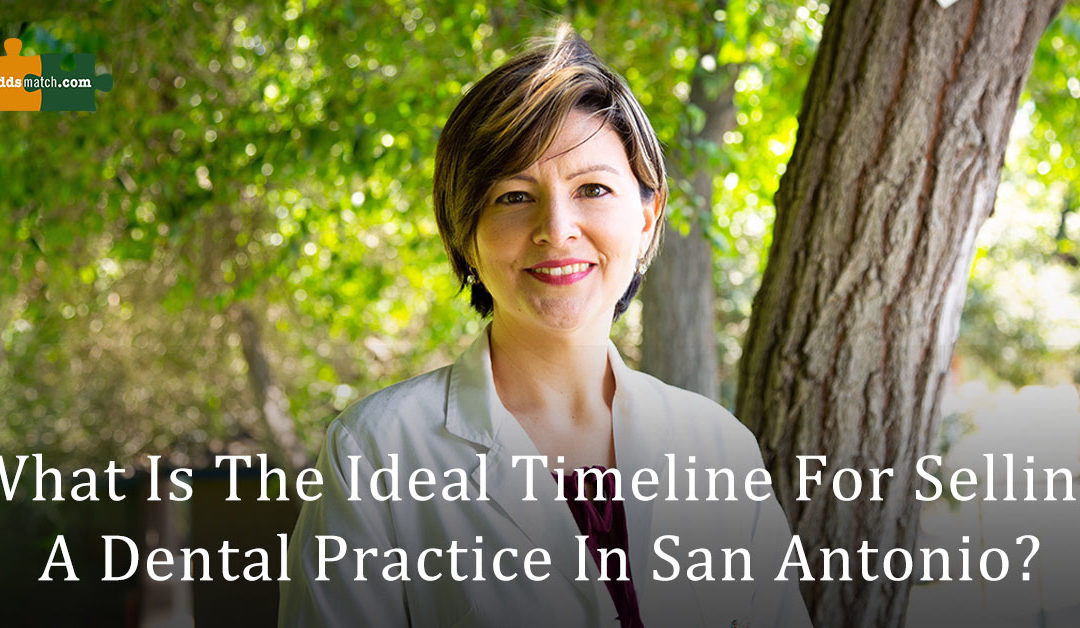There are a variety of reasons dentists decide to sell their practices. Some dentists only start thinking about selling a dental practice when they decide it is time to retire. Others want to move from a rural to an urban area, or decide to move to a new city or state for personal reasons. Whatever the reason may be, one thing holds true for every dentist planning to sell a practice: the sooner you start planning, the more successful your transition will be. But what exactly do we mean by “soon”? Your ideal transition timeline should be tailored to your specific needs before, during, and after the sale. To pin down an ideal timeline you need to know the factors that make up a successful sale. Below, we outline what factors you need to consider, and what a typical timeline is for dentists planning to sell a practice in San Antonio and the surrounding areas.
First Things First: Why are You Selling a Dental Practice in San Antonio?
As we stated above, there are several reasons dentists decide to sell their practice. We have worked with dentists who want to retire from owning their own private practice, but plan to stay active in the industry, as a consultant for example. Other dentists may decide they want to sell their San Antonio practice and buy one in Dallas in order to live closer to extended family.
The main distinction when planning for a sale is whether or not you are planning to retire after the sale is finalized. Where will your income come from after you sell? Do you need the proceeds of your sale, combined with your current retirement investments, to carry you through the final 20+ years of your life? Or do you only need the proceeds to fund your next venture?
Why does it matter what your next steps are? If you are selling a dental practice in San Antonio for personal reasons, your sale will likely need to line up with external factors such as selling your home or starting a new job. If you are selling before retirement you may have a little more flexibility in your timeline. While it is certainly possible to complete a dental practice transition in a matter of months, taking time to plan out your transition and build value in your practice will result in a more successful sale. That is why as soon as you start thinking about selling your practice you should contact a practice transition specialist.
Variables to Consider Before You List Your Practice
Each dentist and practice has a unique set of variables that may help, or hinder, reaching their specific transition goals. Several unexpected variables need to be considered before you decide on your ideal transition timeline. Here are the variables that will impact your transition timeline.
The Value of Your Collections
Not only do your collections impact the sale price of your practice, they are an indicator to buyers of what they can expect to make after they take over. When you are selling a dental practice in San Antonio your buyer will need to know they can cover operating costs and still take home enough to support their lifestyle. The US Bureau of Labor Statistics reports, “the median annual wage for dentists was $159,200 in May 2019.” Your actual annual income will vary based on your location, specialty, overhead costs, and the ebbs and flows of the economy. In addition, newer dentists will likely have significant student loan debt. According to the American Dental Education Association the average debt for dental school graduates was $219,169 in 2019, with 39% of the graduates reporting student loan debt over $300,000. So, whether or not they are freshly out of dental school, it is highly likely that a younger dentist will have to take their student loan debt into consideration when evaluating practices to buy. Will your current take home pay support a dentist in this situation? The higher your take home pay the more attractive your practice will be to buyers, and the shorter your transition timeline can be.
Practice Location
Selling a dental practice in Alamo Heights is a much different experience than selling one Shertz, even though both locations are within the greater San Antonio area. Urban areas are more densely populated, and tend to attract more potential buyers. If your dental practice is located in an urban area you can expect a practice transition to be completed six to twelve weeks after finding a qualified buyer and obtaining a practice valuation. It is worth noting, though, that urban areas tend to have more competition for buyers and highly successful practices that may be financially out of reach for younger dentists.
Practices in rural areas typically take longer to find a buyer, up to three years in some cases. However, the economic health of your specific community will have a lot to do with finding a qualified buyer. San Antonio and the surrounding areas are growing rapidly, and suburbs that were once considered “sleepy” are now growing at incredible rates. Even if your area is still considered “rural” it may be in an up-and-coming area where buyers are looking to snatch up space quickly.
When you’re selling a dental practice in an area that is urban, rural, or somewhere in between, it is important to discuss your ideal timeline with a local broker. Someone who is experienced in dental practice transitions in your area will have their finger on the pulse of the market and can help you decide the right time to list your practice.
Retirement Age
Have you put much thought into when you want to retire? The American Dental Association found that the average age of retirement for dentists in 2017 was 68.9. If you are within ten years of your ideal retirement age it is time to start planning. A successful transition into retirement takes years to plan and involves much more than just putting your practice on the market. That is why our transition experts created the Practice Optimizer Experience, which we will discuss in more detail below. Even if you aren’t planning to retire in the next ten years it is wise to consider how your current sale could affect you down the road.
Selling a Dental Practice Without Retiring
If you are not planning to retire soon, what can you expect your transition timeline to be? Oftentimes our clients who are moving on without retiring need to sell their practice quickly because of external factors. However, this doesn’t mean you can’t get the full value of your practice, or even increase your practice’s value before selling. As soon as you know selling your practice is a possibility, contact one of our transition specialists to talk about a practice valuation.
A practice valuation will give you an accurate record of what is involved in the sale and what the total value of your practice is. At DDSmatch Southwest we work with third-party valuator Blue & Co. for reliable valuations. Your 70-page report will give you insight not only into how much you can expect your practice to sell for, but what you can do to boost value before selling a dental practice in San Antonio. If you have the flexibility to wait a few years before listing your practice there are many things you can do to increase your practice’s value. If you only have a few months before you need to sell, talk to your transition specialist about whether there are any quick and effective ways to increase value in your practice. It is important to note that some “quick and easy” ways many dentists think will add value actually do not provide a 1:1 return on investment. For information on cost-effective ways to add value to your practice visit our dental transitions blog.

Your Retirement Timeline
Even if you don’t know the exact age you want to retire at, you probably know a general range. When you first start to plan your dental practice transition you don’t need to set out specific dates for your retirement. In fact, it is a good idea to remain flexible with your plans in the early stages to make sure you get the full value of your practice. In addition, if you want to take on an associate or reduce your hours before selling a dental practice you need to plan these steps well in advance to avoid unintentionally decreasing your practice’s value.
Ten Years Before Your Dental Practice Transition
As we mentioned above, the average dental professional retires in their late 60s, which is why we recommend dentists in their 50s start preparing their practice for sale. Now is the time to take a look at the equipment and software you use and consider upgrading them. Replacing outdated x-ray equipment or billing software can be costly, and should only be done if you have the time to pay off the equipment and train your staff to use it. Bringing your practice up to date at least ten years before you sell will allow you to benefit from the upgrade while making your practice more attractive to future buyers.
Five Years Before Your Dental Practice Transition
Five years or more before selling a dental practice in San Antonio you should start focusing on streamlining your practice for optimal value. Depending on your practice’s makeup this could mean reducing specialty procedures to make your practice as mainstream as possible. Look at each aspect of your practice and consider whether you could make it more efficient. If you haven’t already, make the switch to a digital filing system and digital x-ray equipment. While these upgrades may be expensive you need to start thinking about your future buyer. Younger dentists won’t know how to use outdated systems and are less likely to choose a practice that will require them to learn or pay to upgrade them.
Two Years Before Your Dental Practice Transition
At least two years, but as many as five years before you plan to sell, review your fees to see where you can raise them and find ways to increase your patient base. Research comparable procedures in your area and consider setting your fees in the 80th percentile. Avoid adding new, specialty procedures, as you will not have time to gain the skill and experience needed to be competitive before you retire.
Remember, when you are selling a dental practice in San Antonio you are selling much more than just the equipment. Now is the time to make sure you have qualified staff in place and that they are paid fairly. Too much turnover is a red flag to potential buyers, while hyper-inflated salaries will reflect lost value. Look at the local job market to make sure your staff’s income reflects their qualifications, abilities, and loyalty.
With a few small exceptions, the time for upgrading your office is over. Focus your efforts on small cosmetic improvements, such as repainting, but avoid larger office remodels. Your goal now is to make a good first impression on your patients and future buyers.
Time To List Your Practice
With the time and effort you put forward over the last ten years, selling your practice should be a breeze. Your dental transition specialist will guide you through the final steps of selling your practice, including getting a reliable practice valuation and connecting you with a dental specific attorney and CPA.
Practice Optimizer Experience
A lot goes into preparing for retirement and selling a dental practice, which is why we created the Practice Optimizer Experience. When you take advantage of these services you can be sure no detail will be overlooked and you can retire on your own terms. The Practice Optimizer Experience includes important steps such as an Ideal Retirement Calculation, Estate Preparedness Gameplan, Dental Insurance Navigator, and Clinical Opportunity Blueprint. Learn more about how we help dentists in San Antonio and beyond prepare, plan, and prioritize for the future by visiting our webpage here.
Contact the experts at DDSmatch Southwest today to learn more about successful dental practice transitions in San Antonio and across the Southwest.

